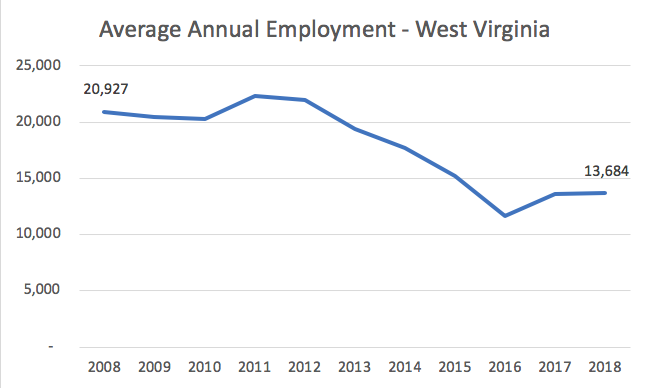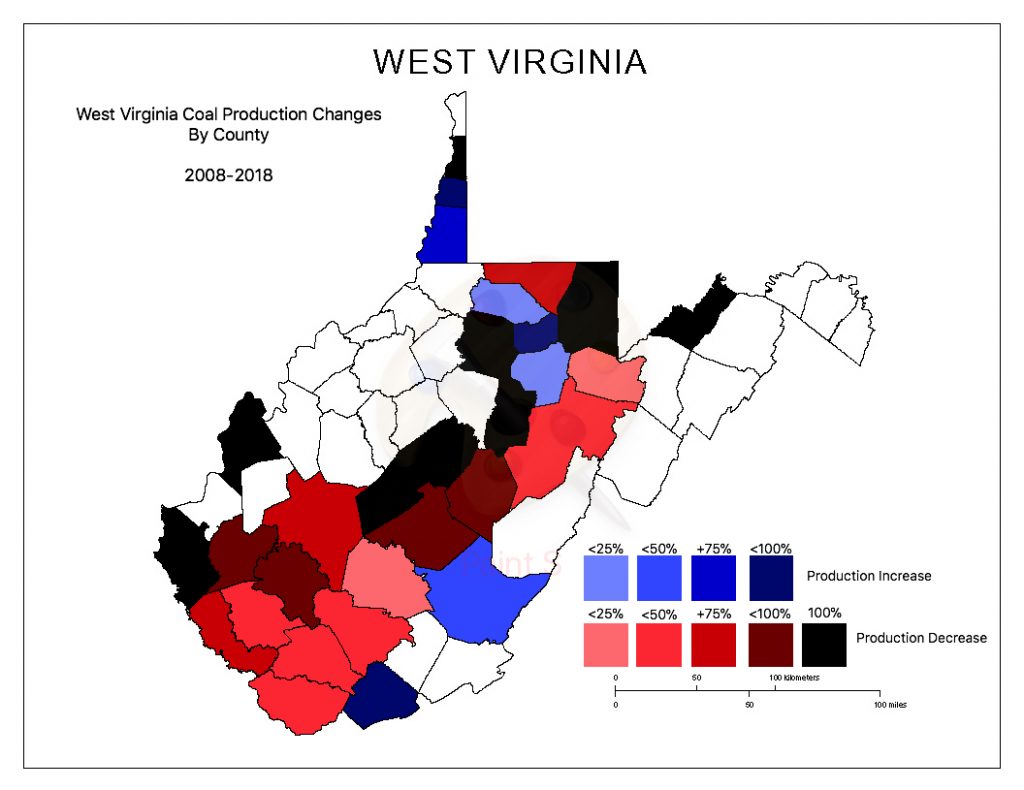Since the election of President Donald Trump in 2016, national and international news outlets have parachuted into West Virginia’s southern coalfields to “explain” the region and its steadfast support for the president. These explanations often mention the “War on Coal” narrative that developed during the Obama Administration and contrast it with Trump’s outspoken support for the coal industry.
The War on Coal, however, is pure spin created by coal industry groups. This propaganda obscures the real causes of coal’s decline: Technological advances, shifting economic demand, and the rise of natural gas. Those changes have led to tens of thousands of American miners to lose their jobs since the end of the 1980s.
When the coal industry peaked in the 1950s, it employed about 125,000 West Virginians. Today, fewer than 15,000 Mountaineers are employed as coal miners. Mine employment has dropped 35 percent in the past decade alone.

The miners of our grandparents’ generation were replaced by modern mining techniques and machines, like continuous miners, which increased a mine’s productivity while making its human labor obsolete. Between 1987 and 2008, coal production increased nationally (though West Virginia struggled to stay dominant over new western coal seams in Wyoming) as employment in the industry steadily declined.
Coal production started to decline in 2008 in West Virginia and the United States. Though West Virginia’s coal industry had grown since 2003, coal production fell by 13 percent in 2008. That trend continued in Obama’s first presidential term, and the coal industry quickly blamed his administration’s environmental initiatives. The constant messaging barrage against President Obama and his party paid dividends for the West Virginia Republican Party and its coal-industry donors in 2014—Democrats lost control of both Houses of the Legislature for the first time since 1933.
The problem with the War on Coal narrative is that economic reality, not Obama’s environmental policies, made many mining jobs obsolete. The profitability of coal has shifted production to the west and north, away from West Virginia’s southern coalfields.
While southern West Virginia’s coal industry was in the middle of a sustained nose dive from 2008 to 2016, coal production and employment in northern West Virginia has modestly increased since 2008. Now, northern West Virginia produces more coal than southern West Virginia.

This contrast is especially stark when comparing the state’s northern panhandle with the southern-most coalfields. Today, the north’s Ohio County is one of the state’s top coal-producing counties with 10.1 million short tons reported in 2018 (it produced zero tons in 2008). But production in Boone County, in the southern Kanawha coalfield, has fallen 86 percent from a state-high 31 million short tons in 2008 to barely over 4 million short tons today.
The economic cost for Boone County has been staggering: Mine closures have led to more than 3,000 jobs being eliminated in the past decade in a county of 22,000 people.

As production in the north creeps up, many of the new mines use the longwall mining technique, which requires even less manpower than continuous mining machines.
Marshall County now leads the state in production, but its coal companies employ less than a third as many miners as Boone County’s companies did a decade ago. Though northern production has helped offset some of the state’s production decline, the jobs are simply not growing at the same pace. While the profits are good for shareholders and CEOs, out-of-work miners cannot find mining work.

The type of coal in northern and southern coalfields also differ. Much of southern West Virginia’s coal was used for steel production, but the northern coalfields are overwhelmingly composed of steam coal used in electric power production.

The fact that West Virginia’s largest decreases in coal production were from met coal mines while steam coal was on the rise refutes any accusations that President Obama’s 2014 Clean Power Plan destroyed the coal industry.
Even after Trump’s reversal of the CPP in 2017, coal-fired power plants have continued to close due to the affordability and regional abundance of natural gas. It’s no wonder that Bob Murray, CEO of coal producer Murray Energy, recently funded a “grassroots” organization to oppose a new natural gas-powered plant in Marshall County.
Interestingly, met coal has seen a slight increase in production since 2016, but not due to any deregulation or scrapping of environmental standards in the United States.
According to a recent report from the West Virginia University Bureau of Business and Economic Research, increases in American (and West Virginia) coal production are spurred by increased demand for coal overseas. Ukraine and India are among the largest importers of West Virginia coal. A third of the state’s coal is now exported, primarily for industrial uses.
The WVU report estimates that the coal industry in both regions of West Virginia should remain generally stable, though it will endure a gradual decline in production.
The coal industry will not boom under the guidance of President Trump. If coal companies are looking for a new savior, perhaps they should look to Ukraine’s new president, as West Virginia’s coal is more likely to fuel a blast furnace in Kiev than Cleveland. The “War on Coal” was not brought on by political changes, but by economic reality.
Subscribe to The Patch, our newsletter, to stay up-to-date with new expatalachians articles and news from around Appalachia.
Nick Musgrave first became fascinated with West Virginia’s history while growing up in Parkersburg. He continues to read, research and write on the Mountain State’s past from its birthplace in Wheeling. For more neat history and some political snark, follow him on Twitter: @NickMusgraveWV.



